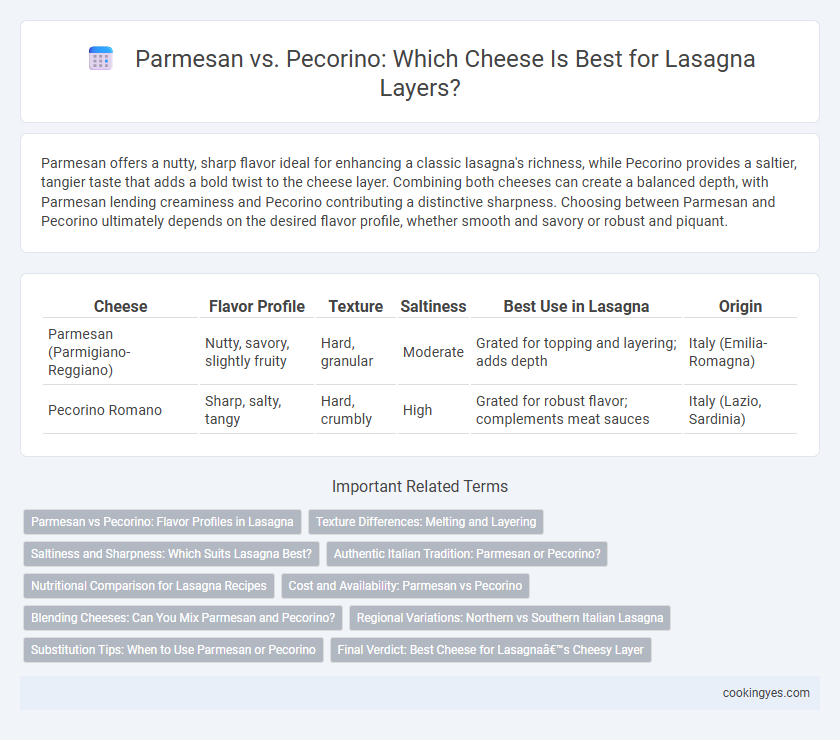Parmesan offers a nutty, sharp flavor ideal for enhancing a classic lasagna's richness, while Pecorino provides a saltier, tangier taste that adds a bold twist to the cheese layer. Combining both cheeses can create a balanced depth, with Parmesan lending creaminess and Pecorino contributing a distinctive sharpness. Choosing between Parmesan and Pecorino ultimately depends on the desired flavor profile, whether smooth and savory or robust and piquant.
Table of Comparison
| Cheese | Flavor Profile | Texture | Saltiness | Best Use in Lasagna | Origin |
|---|---|---|---|---|---|
| Parmesan (Parmigiano-Reggiano) | Nutty, savory, slightly fruity | Hard, granular | Moderate | Grated for topping and layering; adds depth | Italy (Emilia-Romagna) |
| Pecorino Romano | Sharp, salty, tangy | Hard, crumbly | High | Grated for robust flavor; complements meat sauces | Italy (Lazio, Sardinia) |
Parmesan vs Pecorino: Flavor Profiles in Lasagna
Parmesan offers a nutty, savory flavor with a granular texture that melts smoothly into lasagna layers, enhancing richness without overpowering other ingredients. Pecorino, made from sheep's milk, provides a sharper, saltier taste with a crumbly texture that adds boldness and depth to the cheese layer. Choosing Parmesan gives a balanced, mellow profile, while Pecorino delivers a more pronounced, tangy sharpness, influencing the overall flavor complexity of lasagna.
Texture Differences: Melting and Layering
Parmesan cheese offers a granular texture that melts smoothly, creating a creamy and cohesive cheese layer in lasagna, while Pecorino Romano is firmer and saltier with a slightly grainy consistency that retains more structure when heated, providing distinct textural contrast. Parmesan's balanced melting properties help blend seamlessly with bechamel and ricotta layers, enhancing the overall creaminess. In contrast, Pecorino contributes a sharper flavor and a more defined, layered texture, ideal for those seeking a pronounced cheese presence within the dish.
Saltiness and Sharpness: Which Suits Lasagna Best?
Parmesan cheese offers a balanced saltiness and a nutty, umami-rich sharpness that enhances lasagna without overpowering other flavors. Pecorino Romano is notably saltier and has a more pronounced sharpness and tang, which can dominate the delicate layers of sauce and pasta in lasagna. For a harmonious cheese layer that complements the traditional tomato and bechamel sauces, Parmesan is generally preferred due to its milder, more versatile flavor profile.
Authentic Italian Tradition: Parmesan or Pecorino?
Authentic Italian lasagna traditionally favors Parmesan (Parmigiano-Reggiano) for its rich, nutty flavor and granular texture that enhances the layered cheese profile. Pecorino Romano, made from sheep's milk, offers a sharper, saltier taste, often used in regional variations or to add a distinctive tang. Both cheeses contribute unique flavors, but Parmesan remains the cornerstone in classic lasagna recipes rooted in Italian culinary heritage.
Nutritional Comparison for Lasagna Recipes
Parmesan cheese contains approximately 431 calories and 38 grams of protein per 100 grams, providing a rich source of calcium and phosphorus vital for bone health in lasagna recipes. Pecorino Romano has higher sodium content, around 1800 mg per 100 grams, which may influence overall sodium levels in lasagna but offers a stronger, saltier flavor profile. Both cheeses contribute essential nutrients, though Parmesan tends to be lower in fat and sodium, making it a slightly healthier option for cheese layers in traditional lasagna dishes.
Cost and Availability: Parmesan vs Pecorino
Parmesan cheese generally offers a more affordable option compared to Pecorino, making it widely accessible for lasagna cheese layers. Parmesan's global availability in most supermarkets ensures consistent supply, while Pecorino, often imported and more artisanal, tends to have a higher price point and limited regional distribution. Choosing Parmesan supports budget-friendly cooking without compromising on the classic savory flavor essential for traditional lasagna.
Blending Cheeses: Can You Mix Parmesan and Pecorino?
Blending Parmesan and Pecorino in a lasagna cheese layer creates a balanced flavor profile with Parmesan offering a nutty, savory taste and Pecorino providing a sharp, salty intensity. Both cheeses complement each other well, enhancing the umami richness and adding depth to the dish's texture and aroma. Using a mixture typically involves grating equal parts for optimal meltability and consistent seasoning throughout the layers.
Regional Variations: Northern vs Southern Italian Lasagna
Northern Italian lasagna traditionally incorporates Parmesan cheese, prized for its nutty, savory flavor and granular texture that melts smoothly within the layers. In contrast, Southern Italian lasagna often features Pecorino Romano, a sharper, saltier sheep's milk cheese that adds a bold, tangy profile to the dish. These regional variations highlight how local cheese preferences influence the distinct taste and authenticity of lasagna recipes across Italy.
Substitution Tips: When to Use Parmesan or Pecorino
Parmesan cheese, known for its nutty and slightly sweet flavor, is ideal for a balanced lasagna cheese layer that enhances tomato sauce without overpowering other ingredients. Pecorino, with its sharper and saltier profile, works best when a more pronounced, tangy kick is desired, especially in meat or sausage lasagnas. Substitute Parmesan with Pecorino sparingly to avoid excessive saltiness, or blend both cheeses for a complex flavor that elevates traditional recipes.
Final Verdict: Best Cheese for Lasagna’s Cheesy Layer
Parmesan offers a nutty, sharp flavor with a granular texture that melts smoothly, enhancing the lasagna's cheesy layer with a rich, savory depth. Pecorino Romano provides a saltier, tangier profile made from sheep's milk, adding a bold sharpness and firmer texture that stands out in layered dishes. For the best cheese in lasagna's cheesy layer, Parmesan is often preferred due to its balanced flavor and superior meltability, creating a creamy, cohesive texture.
Parmesan vs Pecorino for Lasagna Cheese Layer Infographic

 cookingyes.com
cookingyes.com